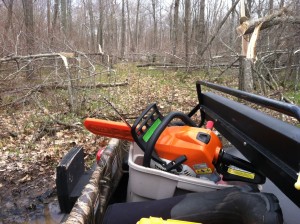Steve Bartylla Hinge Cuts Maintenance
Steve Bartylla Hinge Cuts
Hinge cut maintenance
In one way or another, annually is generally the case. Assuming one makes all the “sidewalks” and doe bedding areas in late winter, the easy walking portion of the “sidewalk” often starts growing in with weeds, briars and saplings during the summer. Late summer is a good time to both spray them with gly and cut the trail portion for easy walking.

The doe bedding areas could use a quick inspection to be sure they haven’t become an impenetrable jungle. Normally, they’re good for a year or two at worst, but they can explode with new growth to the point of being too thick before that, on occasion. If so, a couple trails should be cut through them, as well as making anywhere from 1 to a handful of about 10 yard in diameter openings inside (depending on size…less than 1/2 acre and one works. 1/2 acre-1 acre 2-4).
Assuming a lot of new woody growth occurs in the doe bedding areas and along the “sidewalks” one will eventually need to hinge that growth. The elapsed time will depend on growth rates. You generally don’t have to for 5 or more years, though. I want trees to be about the size of my forearm before I hinge the hinge cut areas again. That’s what I’ve found works best.
On hinge cut screens/blockades, I’m up keeping them annually, sometimes a couple times a year. Unless you’re going to go nuts and hinge a 50 yard swat or something, you almost never stop all deer from crossing these hinge cut blockade/screens. So, once or twice a year during the off season, I’ll “plug” the holes they are using, most often by trying to hinge another tree over the blockade to make it harder to cross there.
In all of this, you never get to the point where plans like these are done and no longer require any more work. Each year, I reevaluate my plans, making any tweaks I feel are beneficial. Each year there is some form of upkeep to be done on at least some of the “improvements” I’ve made. Just like starting new food plots, the first year or two is the most, but the work is never completely done.

